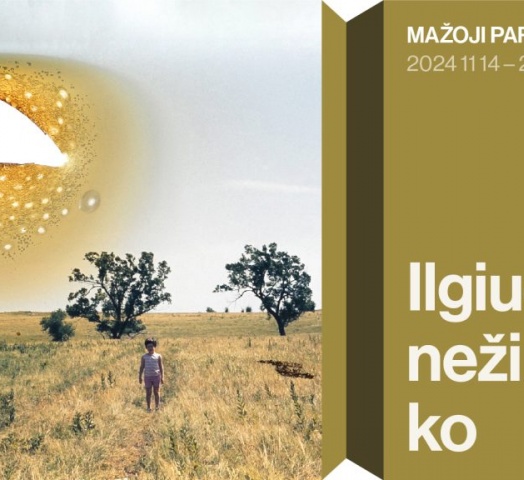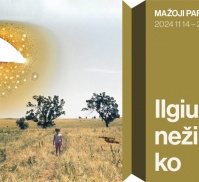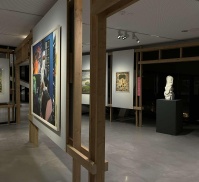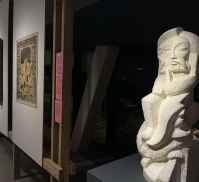Longing, Not Sure What For
On November 14th at the MO museum, exhibition Longing, Not Sure What For was opened. TARTLE has lent the artwork "Thunder" (before 1931) by Juozas Mikėnas for the exhibition.
Is it possible to long for something without knowing exactly what for? Or to feel homesick while you’re actually at home? This precise feeling was given the name “solastalgia” by philosopher Glenn Albrecht in 2005, referring to emotional and existential anxiety in the face of climate change. It is the feeling of being at home and realizing that one’s sense of place is changing or has already changed irreversibly. Thorough a nostalgic and perhaps slightly naïve perspective, this exhibition attempts to grasp, with the tips of our thoughts and fingers, our multifaceted and paradox-filled relationship with nature, when one fabric interweaves both our admiration for and fear of nature, exploitation and love, facts and beliefs.
What is this thing we call nature? Where does it begin and end? When we step out into the yard – is that nature already? What about a park or a forest? And if we were to walk on the surface of the Moon – is nature there, too? The concept of nature is both fiction and unavoidable reality. Our relationship with it is always complicated: If we encounter it directly, through the senses, then it is limited – since we sense everything only with one body in a specific place in the world. And if our encounter with nature is academic and technological, then it may be more global, but it is mediated and still does not encompass the whole. The Earth is simply too large of a whole of cosmic, global, and microscopic actors, and we ourselves are just a tiny part inserted into its billion-year history. Perhaps this is why it is so difficult to think, feel, and make decisions about or take responsibility for climate change? It is a responsibility that demands a scope of concern we have never seen before, one that would change personal and national, economic and political interests.
Nature can be generous and gracious, but also uncontrollable and indifferent. In our history, nature has had thousands of names and faces. Unable to explain or control it, we surrendered the control of nature to abstractions, such as deities, and we came to believe in the grace of the Garden of Eden, Perkūnas/Thor, Žemyna/Mother Earth, Gaia, and other gods. In the same way, we believed (and perhaps still do) in the hope assured by the political, economic, and technological progress of the modern age that nature will never run out. Storms, floods, forest fires, one summer hotter than the next, and the likelihood of future snowless winters signal that nature’s resources are limited, that someone else will not solve these problems, and that we ourselves must rethink our personal and collective relationship with nature. And that nature, one way or another, can manage without us.
___
Exhibition team
Curator: Marius Armonas
Coordinator: Agnė Kuprytė
Architect: Dominykas Šavelis
Graphic designer: Monika Janulevičiūtė
Translator: Darius Sužiedėlis
Editor: Audra Kairienė
Artists
Akvilė Anglickaitė (b. 1982), Ray Bartkus (b. 1961), Alfonsas Budvytis (1949–2003), Vitalijus Butyrinas (1947–2020), Nijolė Dirvianskytė (b. 1944), Nerijus Erminas (b. 1976), Laura Garbštienė (b. 1973), Rokas Janušonis (b. 1997), Danutė Jonkaitytė (b. 1951), Vytautas Juozėnas (b. 1990), Linas Leonas Katinas (1941–2020), Česlovas Lukenskas (b. 1959), Aurelija Maknytė (b. 1969), Lidija Meškaitytė (1926–1993), Juozas Mikėnas (1901–1964), Vytautas Pakalnis (1972–2004), Igoris Piekuras (1935–2006), Romualdas Rakauskas (1941–2021), Rimas Sakalauskas (b. 1985), Šarūnas Sauka (b. 1958), Algimantas Julijonas Stankevičius-Stankus (1933–2002), Birutė Stančikaitė (b. 1952), Liucija Šulgaitė (1933–2013), Jonas Švažas (1925–1976), Rimaldas Vikšraitis (b. 1954), Aleksandras Vinkus-Vitkauskas (1832–1912), Vita Zaman (b. 1976), Audrius Zavadskis (1945–2019), Antanas Žmuidzinavičius (1876–1966), Kazimieras Žoromskis (1913–2004)

On November 14th at the MO museum, exhibition Longing, Not Sure What For was opened. TARTLE has lent the artwork "Thunder" (before 1931) by Juozas Mikėnas for the exhibition.
Is it possible to long for something without knowing exactly what for? Or to feel homesick while you’re actually at home? This precise feeling was given the name “solastalgia” by philosopher Glenn Albrecht in 2005, referring to emotional and existential anxiety in the face of climate change. It is the feeling of being at home and realizing that one’s sense of place is changing or has already changed irreversibly. Thorough a nostalgic and perhaps slightly naïve perspective, this exhibition attempts to grasp, with the tips of our thoughts and fingers, our multifaceted and paradox-filled relationship with nature, when one fabric interweaves both our admiration for and fear of nature, exploitation and love, facts and beliefs.
What is this thing we call nature? Where does it begin and end? When we step out into the yard – is that nature already? What about a park or a forest? And if we were to walk on the surface of the Moon – is nature there, too? The concept of nature is both fiction and unavoidable reality. Our relationship with it is always complicated: If we encounter it directly, through the senses, then it is limited – since we sense everything only with one body in a specific place in the world. And if our encounter with nature is academic and technological, then it may be more global, but it is mediated and still does not encompass the whole. The Earth is simply too large of a whole of cosmic, global, and microscopic actors, and we ourselves are just a tiny part inserted into its billion-year history. Perhaps this is why it is so difficult to think, feel, and make decisions about or take responsibility for climate change? It is a responsibility that demands a scope of concern we have never seen before, one that would change personal and national, economic and political interests.
Nature can be generous and gracious, but also uncontrollable and indifferent. In our history, nature has had thousands of names and faces. Unable to explain or control it, we surrendered the control of nature to abstractions, such as deities, and we came to believe in the grace of the Garden of Eden, Perkūnas/Thor, Žemyna/Mother Earth, Gaia, and other gods. In the same way, we believed (and perhaps still do) in the hope assured by the political, economic, and technological progress of the modern age that nature will never run out. Storms, floods, forest fires, one summer hotter than the next, and the likelihood of future snowless winters signal that nature’s resources are limited, that someone else will not solve these problems, and that we ourselves must rethink our personal and collective relationship with nature. And that nature, one way or another, can manage without us.
___
Exhibition team
Curator: Marius Armonas
Coordinator: Agnė Kuprytė
Architect: Dominykas Šavelis
Graphic designer: Monika Janulevičiūtė
Translator: Darius Sužiedėlis
Editor: Audra Kairienė
Artists
Akvilė Anglickaitė (b. 1982), Ray Bartkus (b. 1961), Alfonsas Budvytis (1949–2003), Vitalijus Butyrinas (1947–2020), Nijolė Dirvianskytė (b. 1944), Nerijus Erminas (b. 1976), Laura Garbštienė (b. 1973), Rokas Janušonis (b. 1997), Danutė Jonkaitytė (b. 1951), Vytautas Juozėnas (b. 1990), Linas Leonas Katinas (1941–2020), Česlovas Lukenskas (b. 1959), Aurelija Maknytė (b. 1969), Lidija Meškaitytė (1926–1993), Juozas Mikėnas (1901–1964), Vytautas Pakalnis (1972–2004), Igoris Piekuras (1935–2006), Romualdas Rakauskas (1941–2021), Rimas Sakalauskas (b. 1985), Šarūnas Sauka (b. 1958), Algimantas Julijonas Stankevičius-Stankus (1933–2002), Birutė Stančikaitė (b. 1952), Liucija Šulgaitė (1933–2013), Jonas Švažas (1925–1976), Rimaldas Vikšraitis (b. 1954), Aleksandras Vinkus-Vitkauskas (1832–1912), Vita Zaman (b. 1976), Audrius Zavadskis (1945–2019), Antanas Žmuidzinavičius (1876–1966), Kazimieras Žoromskis (1913–2004)









